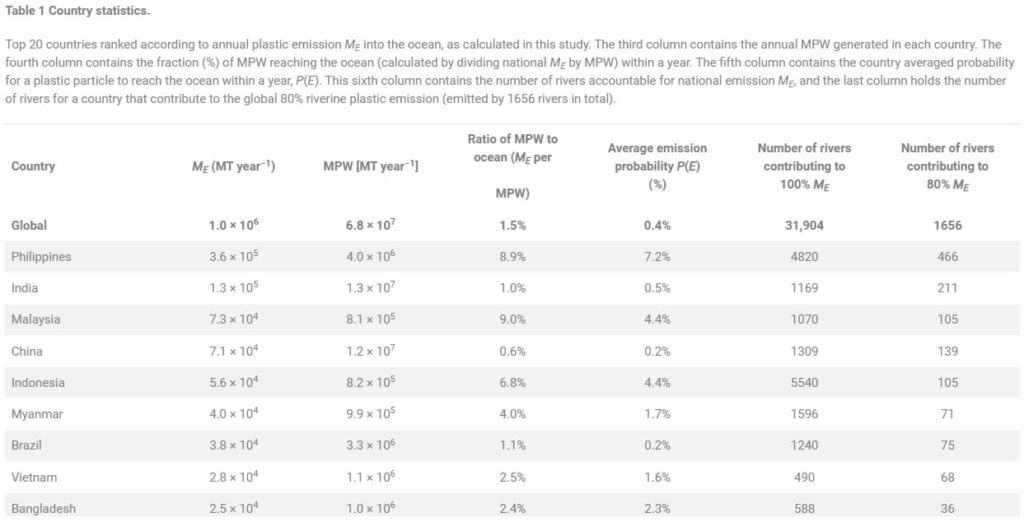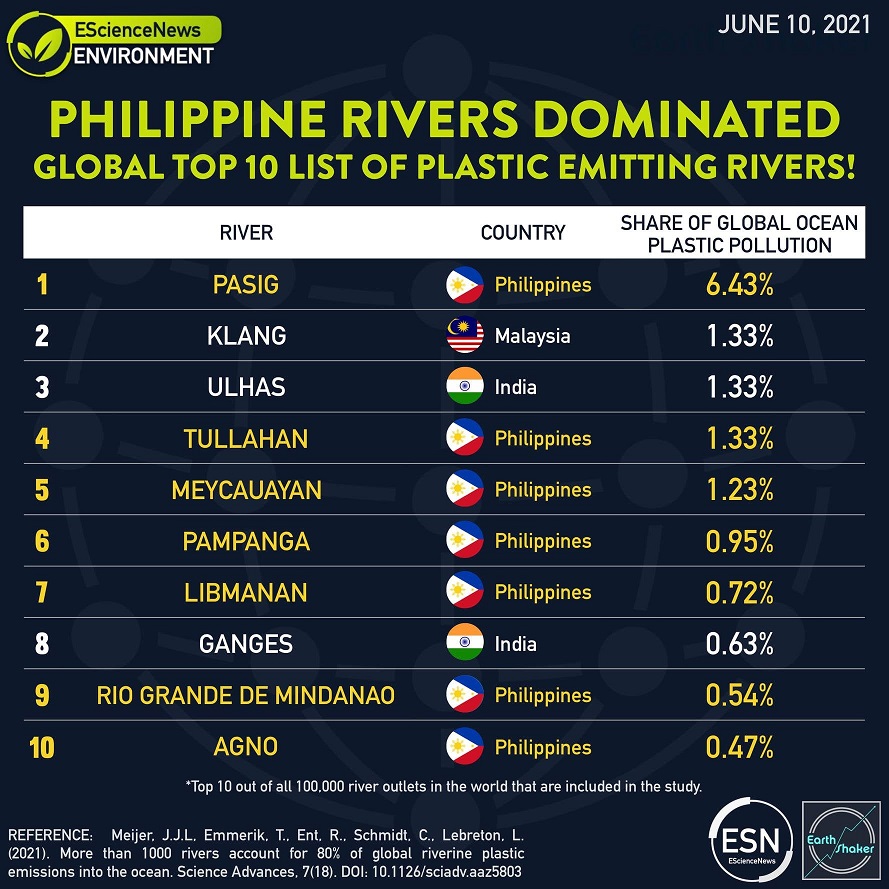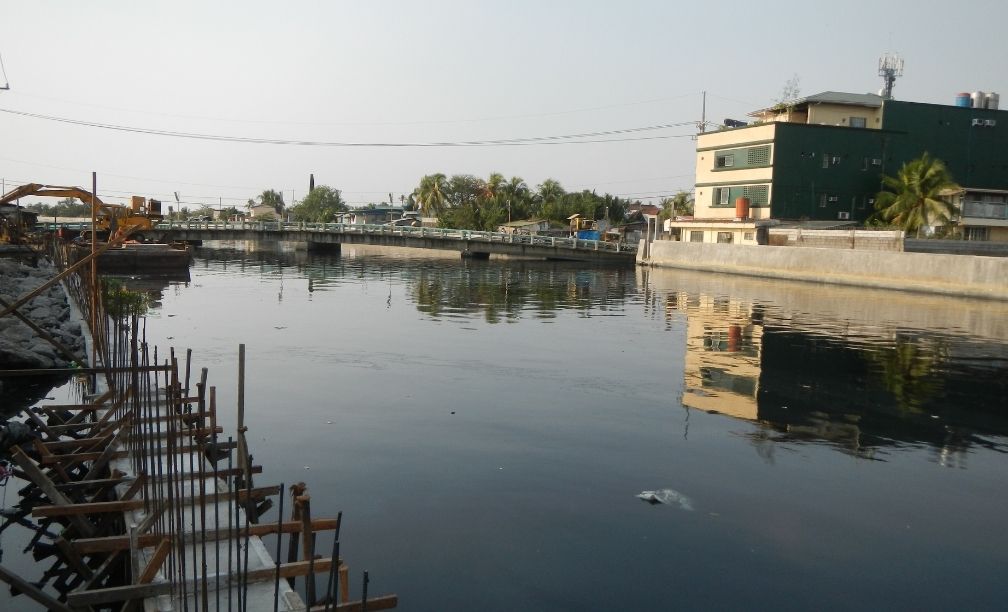Science Advances released an article last April 30, 2021, entitled “More than 1000 rivers account for 80% of global riverine plastic emissions into the ocean.” Science Advances is a peer-reviewed multidisciplinary open-access scientific journal established in early 2015. It is the first open-access journal published by the American Association for the Advancement of Science, making it a trustworthy and reliable source.
Read More than 1000 rivers account for 80% of global riverine plastic emissions into the ocean
Bulakenyos are disgusted to learn that the Meycauayan River is ranked 5th in the Global List of Plastic-Emitting Rivers of 2021. We, Bulakenyos, know it is awfully filthy but never thought it would be this high in the global ranking. We still have a handful of clean rivers in San Miguel, Doña Remedios Trinidad (DRT), and Norzagaray, but we need to protect them from suffering the same fate. We need to revive the Meycauayan River.
Global List of Plastic Emitting Rivers 2021
The article caught the attention of Filipino netizens and local news media companies because it ranked the Philippines as the top contributor of plastic emissions into the world ocean. The Philippines alone contribute about 1/3 of the global total – much higher than those coming from the continents of Africa, North America, South America, Europe, and Oceania combined!

In tackling ocean plastic pollution, we need to know where they are coming from and what factors play a role in their transport from settlements to oceans. Here’s a good summary by Earth Shakers:
- Rivers contributed 0.8-2.7 million tons of plastic into the oceans. Of the 100,000 rivers included in the study, only 1/3 actually contributed to it – with the remaining 2/3 emitted almost no plastic to the ocean!
- The research suggested that smaller rivers played a much larger role than previously thought – with 1,656 rivers contribute 80% of plastic inputs to the ocean. This differs from previous studies showing that only 5 rivers (Schmidt et al., 2017) or 162 rivers (Lebreton et al., 2017) contributed the 80%
- Most of the world’s largest emitting rivers are in Asia, where about 81% of the ocean plastics are emitted. The Philippines, the top-emitting country, alone contributes around 36.4% of the world’s total – much higher than the most populous countries (China – 7% and India – 13%)!
- Seven out of the 10 top-emitting rivers are from the Philippines, with Pasig River alone contributing 6.4% of global river plastics – higher than the contribution of North America (5.4%), Europe (0.6%), and Oceania (0.37%) combined. This deviates from the previous expectations that large rivers, such as the Yangtze, contribute the most.
- The study highlighted some important factors determining how the top-emitting rivers contribute more than the others: (1) they are from areas with poor local waste management practices, (2) they have cities nearby, (3) experience more rainfall, and (4) the cities themselves are near the coast.
- Though richer countries produce much more plastic waste per person than poorer countries, the probability of having more plastics draining into the ocean is affected by the climate, geographical setting, and local waste management practices.

In summary, this study showed the importance of having a global approach to tackling ocean plastic pollution. Focusing mitigation strategies in richer countries won’t make much difference because their ocean plastic inputs are low. Instead, they should help poorer countries in improving waste management facilities and practices. Furthermore, we must speed up our shift to more sustainable alternatives to plastics – because, in the end, the problems will continue circulating and worsen if we won’t take drastic actions.
Where is the Meycauayan River?

The Meycauayan River is part of the Marilao-Meycauayan-Obando river system (MMORS). It is considered one of the most severely polluted rivers in the Philippines and the world due to heavy metal and organic pollution that has caused environmental degradation. In fact, the Meycauayan River contributing 1.23% of global river plastics – higher than the contribution of Europe (0.6%) and Oceania (0.37%) combined.
The deterioration of the Meycauayan River results from rapid industrialization, urbanization, poor planning, and population growth. Examination of the river’s water quality indicates that it is very polluted and requires an immediate solution.
In 2001, the Department of Environment and Natural Resources (DENR) identified the Marilao, Meycauayan, Balagtas, Bocaue, and Guiguinto rivers as “biologically dead.” Most pollutants are tanneries, jewelry manufacturers, food manufacturing, and processing plants along the river. Wet markets and residents living along the watershed and dumping wastewater directly to the river without proper wastewater treatment facilities also contribute to river pollution.
Is there a chance to revive the Meycauayan River?
Environmental experts agree that there is hope to revive the dead river. Still, it will cost a lot of money, inter-government partnerships and legislation (local and national) to fix this complicated problem in the next three to five years.
There are a handful of sewerage treatment plants in Bulacan, but it is not enough to handle the sheer volume of domestic wastewater. San Miguel Corporation (SMC) is currently dredging the Tullahan river section from Barangay Tanong in Malabon City to the river’s mouth leading to Manila Bay in Navotas City. The pipeline is also the river channel improvement of tributaries belonging to the Marilao-Meycauayan-Obando River System (MMORS).
About 1,300 cleanup drives on various rivers and coastal areas in Bulacan were conducted by the Department of Environment and Natural Resources (DENR) since #BattleForManilaBay in 2019. Bulacan Provincial Environment and Natural Resources Officer Emelita Lingat said approximately 6,000 volunteers participated in these cleanup drives, which resulted in the collection of over 357,000 tons of solid waste.
In a statement, DENR Regional Executive Director Paquito Moreno Jr. said they would conduct more river and coastal cleanups; delineation and recovery of river easement areas; grubbing; installation of floating trash traps; conduct of information, education, and communication activities; and resettlement of informal settlers this year in the Manila Bay areas of Central Luzon covering the provinces of Pampanga, Bulacan, Bataan, Tarlac, and Nueva Ecija.
Ultimately, the biggest problem is the people polluting the rivers. So we need to be mindful of our environment.
The government also needs to step up doing the following:
- Continuous and inclusive river clean up drives
- Support dredging projects
- Resettlement of informal settlers as soon as possible
- Building more wastewater and sewerage treatment facilities
- Heavily penalizing environmental law violators (private sectors) and enablers (corrupt DENR and government officials)
- Standard sewerage and flood control canal systems in the Philippines
- Seek help from our neighboring countries with successful and clean river systems like Singapore, Japan, South Korea, and Taiwan.
- Use technology to collect garbage from the river automatically
- Challenge the status quo
Sources:
- Datu, C. L. J. (2021, February 3). DENR intensifies efforts to save Bulacan portion of Manila Bay. PIA News. https://pia.gov.ph/news/articles/1065845.
- Meijer, L. J. J., Emmerik, T. van, Ent, R. van der, Schmidt, C., & Lebreton, L. (2021, April 1). More than 1000 rivers account for 80% of global riverine plastic emissions into the ocean. Science Advances. https://advances.sciencemag.org/content/7/18/eaaz5803.
- Balbin, M. (2019, August 21). River system clean-up project launched in Bulacan. Philippine News Agency RSS. https://www.pna.gov.ph/articles/1078370.
- The Bulacan town where chickens are slaughtered and the river is dead. Philippine Center for Investigative Journalism. (n.d.). https://pcij.org/article/4522/the-bulacan-town-where-chickens-are-slaughtered-and-the-river-is-dead.
- Person. (n.d.). DENR says 5 Bulacan rivers dead. Philstar.com. https://www.philstar.com/nation/2001/02/23/104518/denr-says-5-bulacan-rivers-145dead146.
- River Cleaning – The revolutionary system for cleaning rivers. Rivercleaning. (2021, March 18). https://rivercleaning.com/river-cleaning-system/.
- Yahoo! (n.d.). How cities around the world have cleaned and revived their Rivers. Yahoo! Finance. https://in.finance.yahoo.com/photos/cities-around-world-cleaned-revived-slideshow-wp-185414355/.